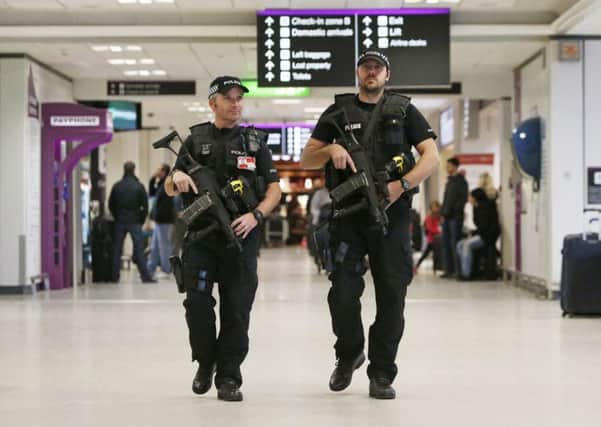Kenny MacAskill: We do not need routinely armed police '“ they need more support and protection


It’s a debate that’s not just recent following the tragic events in London, but has been ongoing over the years. Before I even became Justice Secretary, when still in opposition, I recall attending a Scottish Police Federation Conference. The issue then was on the routine provision of CS spray for officers. I recall being sceptical and public debate was ongoing,with opinion deeply divided.
However, its issuing has been vital for the safety of officers; as well as members of the public. Moreover, its use has been both limited and proportionate. Checks exist with even an accidental discharge requiring to be reported and oversight carried out on every incident by the Police Investigation and Review Commissioner (PIRC). It’s as much if not more of a protection than a baton now for an officer in a dangerous situation. It shows why the concerns and counsel of the Federation should be listened too.
Advertisement
Hide AdAdvertisement
Hide AdOf course, arming the police is much more significant than the provision of spray. The decision whether to have armed police is undoubtedly a political decision given its consequences for society. The effects both practically and psychologically are far more serious. Death can follow for those shot as has been seen in London whether understandably for those on a murder spree, or tragically in a few other cases. As can a distancing in the relationship between police and public as is often the case in other jurisdictions. There’s many a country a visitor wouldn’t ask the time from a police officer or venture into a police station to seek tourist advice. That it routinely happens here is a credit to the constabulary; and both police and public want it to stay that way.
But, how they’re deployed should be a police decision based on intelligence and risk assessment. There are things that are required to be kept confidential for public safety. They cannot be disclosed on the floor of Parliament but are under the scrutiny of a parliamentary committee, the Scottish Police Authority and the Justice Secretary.
The events in London have happened and cannot be wished away any more than the life of Pc Palmer can be brought back. There has to be an assessment and lessons learned. That will undoubtedly impact on the issue of officers and firearms given his death as an unarmed officer. That’s not new of course. After every such incident, whether in this country or abroad, reviews take place and changes if deemed necessary are invoked. I was privy to discussions following past terrorist actions in both the UK and elsewhere; and the attack on the Canadian Parliament in Ottawa a few years back was likewise.
Thankfully, this time it takes place with a more measured response from politicians. The previous Chief Constable Sir Stephen House was hounded mercilessly. Whilst that may have been the febrile atmosphere of the pre-referendum period it was still shameful. The faux outrage then of politicians grandstanding against armed officers; contrasted with the eulogies rightly given last week for Pc Palmer and the action of his colleagues.
Then, though, some politicians railed against armed police patrols, they never complained that Armed Response Vehicles (ARV) would invariably be situated near Holyrood, ready to respond, when they were sitting. Indeed, some privately wanted greater armed protection. The appalling incident in London has also seen a decision taken to have officers patrolling outside Holyrood carry Tasers. That seems to have been welcomed not criticised by politicians.
The past decision by the Chief Constable was made on the basis of information had and risk assessed; not on a personal whim or fancy. It involved the deployment of an increased number of armed officers. Criticism was made of it and where they were to be deployed. However, those making the attacks ignored the fact that, though Edinburgh as with London remained the principle targets, major gun incidents in England had been in more rural areas and gun ownership in rural Scotland is far higher than in urban areas. As well as facing terrorist attack the police need to address disgruntled and distressed individuals with access to firearms.
Moreover, his decision to insist that armed officers be ready to act instantaneously was also condemned. That despite an incident in Edinburgh when an ARV deployed to a deranged man with a knife on Princes Street, saw the first officer out of the vehicle stabbed; and his colleague require to fire the Taser that was primed and at his side. The events in London have reinforced that being ready to act immediately is necessary.
Finally, there was condemnation of them carrying their guns whilst buying a bottle of water or a sandwich. The same logic applies and officers are allowed to get thirsty or hungry. Moreover, with officer numbers limited, armed officers need to assist colleagues or work won’t get done. Last time officers were condemned for sporting side arms when being the first available to respond to an old lady being injured on a bus. Now it will be seen as sensible not outrageous.
Advertisement
Hide AdAdvertisement
Hide AdFollowing the Westminster attack the number of armed officers will be increased. Their use will be as Sir Stephen House suggested, in that he was prescient. Some politicians should hang their heads in shame at what they said. Moreover, if carrying Tasers is needed for politicians, it should be available for public and police themselves. There won’t be routine arming of all officers, nor even carrying of Tasers, but there must be adequate support and protection for them.